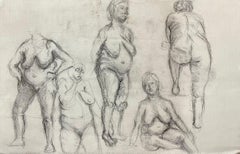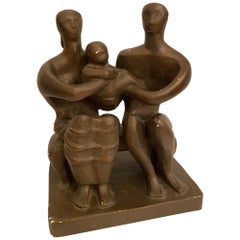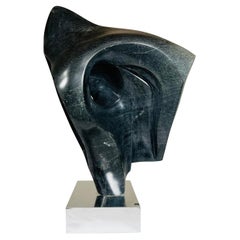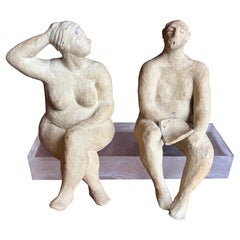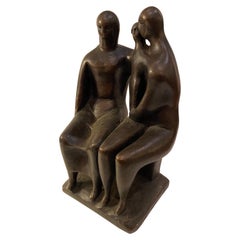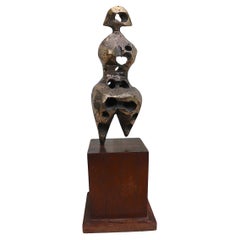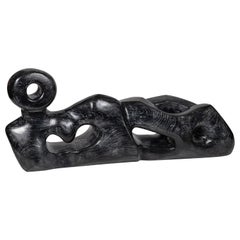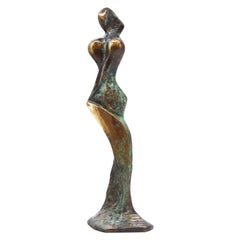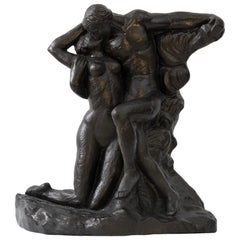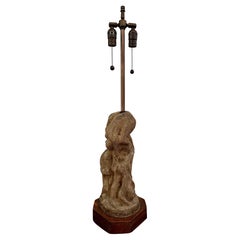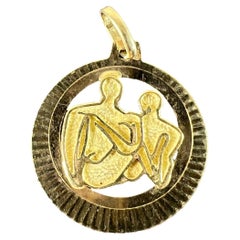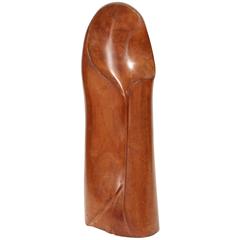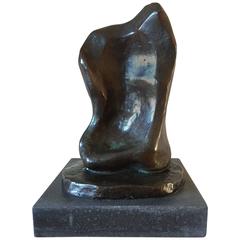Henry Moore Style
Mid-20th Century Modern Figurative Drawings and Watercolors
Carbon Pencil
Vintage 1960s American Modern Figurative Sculptures
Plaster
Mid-20th Century American Mid-Century Modern Abstract Sculptures
Stone, Steel, Chrome
Late 20th Century American Modern Figurative Sculptures
Ceramic
Vintage 1960s American Mid-Century Modern Abstract Sculptures
Plaster
Mid-20th Century American Brutalist Figurative Sculptures
Brass
Vintage 1980s American Abstract Sculptures
Wood
1950s Modern Abstract Prints
Metal
2010s Polish Modern Figurative Sculptures
Bronze
20th Century American Mid-Century Modern Figurative Sculptures
Stone
Vintage 1950s American Brutalist Table Lamps
Stone
Vintage 1930s American Pendant Necklaces
Gold, 14k Gold, Yellow Gold
Mid-20th Century Italian Mid-Century Modern Figurative Sculptures
Murano Glass
Mid-20th Century Abstract Expressionist Abstract Paintings
Pastel, Tempera
Early 2000s Argentine Modern Abstract Sculptures
Stone, Metal
1960s Surrealist Abstract Prints
Etching, Aquatint
1960s Surrealist Abstract Prints
Etching
1960s Pop Art Figurative Prints
Lithograph
1960s Surrealist Abstract Prints
Etching
1960s Abstract Prints
Etching, Aquatint, Intaglio
Recent Sales
Late 20th Century Bolivian Modern Abstract Sculptures
Wood
Vintage 1960s American Modern Figurative Sculptures
Bronze
Mid-20th Century Cubist Figurative Prints
Lithograph
Late 20th Century Hungarian Organic Modern Abstract Sculptures
Hardwood
Vintage 1970s Organic Modern Abstract Sculptures
Hardwood
Vintage 1950s American Mid-Century Modern Figurative Sculptures
Onyx, Bronze
Mid-20th Century Modern Abstract Sculptures
Bronze
Mid-20th Century Mid-Century Modern Abstract Sculptures
Stone
Vintage 1960s Mid-Century Modern Abstract Sculptures
Marble
Late 20th Century Modern Figurative Sculptures
Composition
Mid-20th Century German Mid-Century Modern Abstract Sculptures
Bronze, Brass
Mid-20th Century Abstract Sculptures
Bronze
Vintage 1950s Swedish Scandinavian Modern Abstract Sculptures
Teak
20th Century American Mid-Century Modern Decorative Art
Marble
20th Century American Sculptures
Stone, Steel
1950s Modern Abstract Prints
Metal
20th Century American Mid-Century Modern Busts
Metal
Vintage 1930s American Brutalist Table Lamps
Stone
Vintage 1960s American Sculptures
20th Century English Table Lamps
Mid-20th Century Belgian Figurative Sculptures
Bronze
Late 20th Century Abstract Abstract Sculptures
Ceramic, Glaze
21st Century and Contemporary Abstract Abstract Sculptures
Bronze
1960s Abstract Prints
Etching, Aquatint, Intaglio
Vintage 1960s Dutch Mid-Century Modern Abstract Sculptures
Granite
Vintage 1960s American Mid-Century Modern Figurative Sculptures
Marble, Bronze
Vintage 1960s Mid-Century Modern Abstract Sculptures
Clay
Mid-20th Century American Mid-Century Modern Abstract Sculptures
Teak
20th Century American Organic Modern Stools
Vintage 1960s English Mid-Century Modern Prints
Paper
Vintage 1980s American Expressionist Sculptures and Carvings
Wood
Mid-20th Century British Mid-Century Modern Abstract Sculptures
Bronze
Mid-20th Century German Modern Busts
Marble, Stone
Vintage 1950s American Mid-Century Modern Figurative Sculptures
Mahogany
1960s Surrealist Abstract Prints
Etching, Aquatint
1960s Surrealist Abstract Prints
Etching, Aquatint
1960s Surrealist Abstract Prints
Etching
21st Century and Contemporary Abstract Sculptures
Bronze
2010s Abstract Abstract Sculptures
Bronze
1960s Modern Abstract Prints
Etching, Aquatint
1960s Modern Abstract Prints
Etching, Aquatint
20th Century Table Lamps
20th Century Abstract Sculptures
Late 20th Century Asian Garden Ornaments
Fiberglass
20th Century Busts
Vintage 1950s American Sculptures
Bronze
Vintage 1950s Sculptures
20th Century American Decorative Objects
Metal
Vintage 1970s Organic Modern Figurative Sculptures
Stone, Concrete
Vintage 1970s Organic Modern Abstract Sculptures
Stone
Vintage 1960s Mid-Century Modern Figurative Sculptures
Bronze
Unknown Brutalist Sculptures
20th Century European Sculptures
Marble, Bronze
20th Century American Sculptures
Marble, Bronze
Vintage 1970s Sculptures
Marble
Mid-20th Century Unknown Mid-Century Modern Abstract Sculptures
Rosewood
Antique Mid-19th Century Italian Modern Figurative Sculptures
Ceramic
People Also Browsed
2010s Dutch Modern Serving Bowls
Travertine
Mid-20th Century Unknown Mid-Century Modern Sculptures and Carvings
Softwood
Vintage 1960s Mexican Mid-Century Modern Paintings
Paint
Vintage 1960s American Mid-Century Modern Wall Clocks
Metal
2010s American Modern Table Lamps
Ceramic
Vintage 1960s Danish Scandinavian Modern Credenzas
Teak
Vintage 1970s Swedish Mid-Century Modern Abstract Sculptures
Bronze
Vintage 1980s American Mid-Century Modern Abstract Sculptures
Marble, Bronze
21st Century and Contemporary Indonesian Mid-Century Modern Dining Room ...
Wood
2010s Contemporary Abstract Sculptures
Stainless Steel
21st Century and Contemporary Danish Scandinavian Modern Armchairs
Sheepskin
Antique Mid-19th Century American Mid-Century Modern Abstract Sculptures
Wood
2010s Australian Post-Modern Desk Sets
Brass
Vintage 1950s American Mid-Century Modern Outsider and Self Taught Art
Metal
Vintage 1970s American Mid-Century Modern Table Lamps
Ceramic
Late 20th Century American Organic Modern Abstract Sculptures
Granite, Bronze
Henry Moore Style For Sale on 1stDibs
How Much is a Henry Moore Style?
- 1stDibs ExpertJune 6, 2024Henry Moore's style of art was modern. He is best known for his monumental bronze sculptures, which are installed around the world, often as public art. He used abstract forms of the human body, typically depicting mother-and-child or reclining figures. His more abstract forms are generally pierced or contain hollow spaces. Many critics have likened the undulating shapes of his reclining figures to the landscape and hills of his Yorkshire birthplace. On 1stDibs, find an assortment of Henry Moore art.
- Why did Henry Moore draw hands?1 Answer1stDibs ExpertMay 30, 2024Henry Moore drew hands to symbolize the passage of time. His series of drawings depicting his own hands in old age and other elderly people's hands were meant to represent the effects of work and living on the human body. Much of Moore's work reflected on the human form, including his large bronze sculptures. Explore a diverse assortment of Henry Moore art on 1stDibs.
- 1stDibs ExpertApril 5, 2022Henry Moore’s sculptures often represented the connection between the human body and landscapes. The underlying meaning is that humanity is shared with the natural world, and many of his large-scale sculptures were created to compliment the outdoor landscape where they were placed. You’ll find a selection of Henry Moore sculptures and sketches on 1stDibs.
- 1stDibs ExpertMay 3, 2024Opinions vary as to what Henry Moore's most famous piece is. Since the British artist's semi-abstract monumental bronze sculptures are often public works of art, many have become well known. Among them are Reclining Figure: Festival (1951), Harlow Family Group (1954-5), Helmet Head No. 4: Interior/Exterior (1963), The Arch (1963-69) and Mother and Child (1983). On 1stDibs, find a variety of Henry Moore art.
- 1stDibs ExpertApril 5, 2022Henry Moore frequently used the wax resist process in his drawings, which involved sketching the forms in wax crayon and coating the drawing with a wash of gray watercolor. He then went in with black ink, gray and black crayons and white watercolor. Find a selection of Henry Moore artwork from top art dealers around the world on 1stDibs.
- 1stDibs ExpertApril 26, 2024Henry Moore created sculptures for a few reasons. Born in Castleford, Yorkshire, in 1898, he had an early interest in being a sculptor, and in 1921, he was awarded a scholarship to study at the Royal Academy of Art in London. As he would explain, this is where he was particularly inspired to pursue his sculpting practice: “Even when I was a student I was totally preoccupied by sculpture in its full spatial richness, and if I spent a lot of time at the British Museum in those days, it was because so much of the primitive sculpture there was distinguished by complete cylindrical realization.” He also had an interest in exploring how the human body connected to landscapes. He often produced works with specific locations in mind, considering how his figures would relate to the space around them. His forms are usually abstractions of the human body, typically depicting mother-and-child or reclining figures, and are often pierced or contain hollow spaces. Many interpreters liken the undulating form of his reclining figures to the landscape and hills of his Yorkshire birthplace. On 1stDibs, shop a variety of Henry Moore art.
- Why did Henry Moore draw sheep?1 Answer1stDibs ExpertMarch 13, 2024Henry Moore drew sheep for a few reasons. The British artist thought sheep were peaceful and found watching them graze to be relaxing. He also liked how they stood out against the landscape due to their coloring, likening it to the way a statue draws the eye away from the rest of its surroundings. On 1stDibs, find a diverse assortment of Henry Moore art.
- 1stDibs ExpertAugust 20, 2024How much a Henry Moore statue is worth depends on its history, condition and other factors. In 2022, his Reclining Figure: Festival, created for the 1951 Festival of Britain, set an auction record for the artist when it sold for $31 million. The piece is a good example of the artist's forms, which are usually abstractions of the human figure, typically depicting a mother and child or reclining figure. Moore's works are often suggestive of the female body, apart from a period in the 1950s when he sculpted family groups. If you own a Henry Moore statue, a certified appraiser or experienced art dealer can help you determine its estimated value. Shop an assortment of Henry Moore art on 1stDibs.
- 1stDibs ExpertApril 5, 2022Henry Moore moved to London to study art and often visited the British Museum where he was inspired by ancient sculptures from Egypt, Africa and Mexico. His sculptures have a semi-abstract nature, but he often dabbled in other styles of art. Moore even created his own form of modernism with an eye toward the abstract. On 1stDibs, find a variety of original artwork from top artists.
- 1stDibs ExpertApril 5, 2022Henry Moore used holes in his sculptures to create the illusion that his work was growing from an empty center. His sculptures Oval with Points and Double Oval are two examples of the technique. You'll find a selection of Henry Moore art on 1stDibs.
- 1stDibs ExpertOctober 30, 2024Yes, Barbara Hepworth knew Henry Moore. They met while she was attending the Leeds School of Art in the 1920s. Moore and Hepworth maintained a friendly rivalry throughout their careers. Along with Paul Nash and Ben Nicholson, the two founded the Unit One art movement in 1933. The movement's purpose was to promote avant-garde art in the UK. Explore a wide variety of Barbara Hepworth art.
- 1stDibs ExpertNovember 20, 2024Yes, Henry Moore and Barbara Hepworth were friends. The two met at the Leeds School of Art in the UK and maintained a friendly rivalry throughout their careers. Both Hepworth and Moore were members of Unit One, a group of British artists who sought to educate the public about avant-garde art during the 1930s. Shop a selection of Henry Moore and Barbara Hepworth art on 1stDibs.
- 1stDibs ExpertApril 5, 2022Henry Moore was a prolific artist and it’s difficult to pinpoint exactly how many pieces of art he created. The Henry Moore Foundation lists that their online catalogue of his works currently features more than 11,000 sculptures, drawings, tapestries, textiles and graphics. That’s a significant number indeed and does not represent all of his contributions to the art world. On 1stDibs, find a variety of original artwork from top artists.
- 1stDibs ExpertFebruary 7, 2024Henri Matisse's art style is associated with several movements, including Postimpressionism and Fauvism. He was also the leading proponent of Fauvism, a movement with a name derived from the French word for "wild beast." Marked by vibrant hues, Fauvist paintings like Matisse's famous 1906 composition Le Bonheur de Vivre use wild, active brushstrokes and a palette unconstrained by nature, resulting in women with purple skin and trees with orange leaves. Often, these compositions unite pure color with the white of the exposed canvas to create a sense of transparency and light. Shop a variety of Henri Matisse art on 1stDibs.
- 1stDibs ExpertApril 5, 2022Henri Matisse's artistic style is largely classified as Fauvism. His colorful, expressive paintings also helped to influence Expressionist art. Some of the French artist's most famous paintings include Blue Nudes, La Danse and Le Bonheur de Vivre. Find a collection of Henri Matisse on 1stDibs.
- 1stDibs ExpertSeptember 23, 2024Henri Rousseau's style of painting is called Post-Impressionism. Artists working in this style turned away from the realistic depictions of subjects common in Impressionism and began experimenting with bold colors and textures. Experts also categorize some of Rousseau's works as examples of Primitivism, a movement where artists used inspiration from tribal and folk art to inform their works. On 1stDibs, shop a range of Henri Rousseau art.
